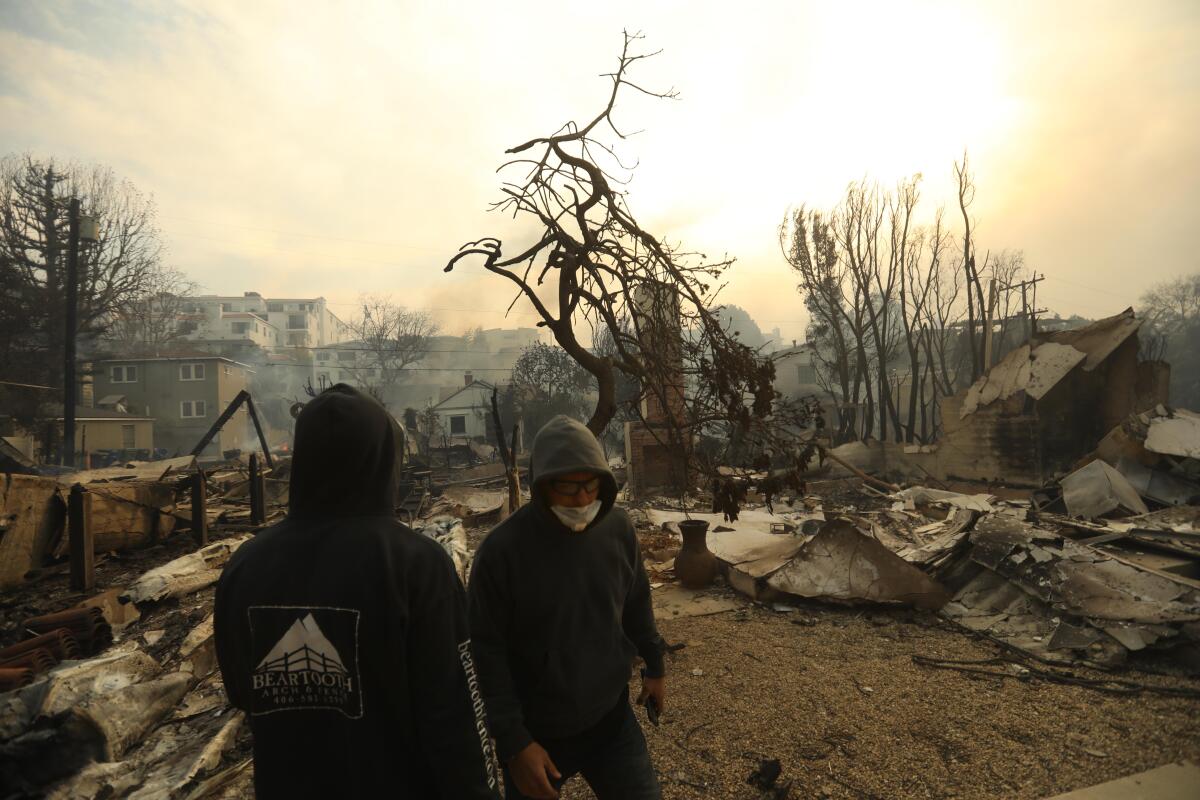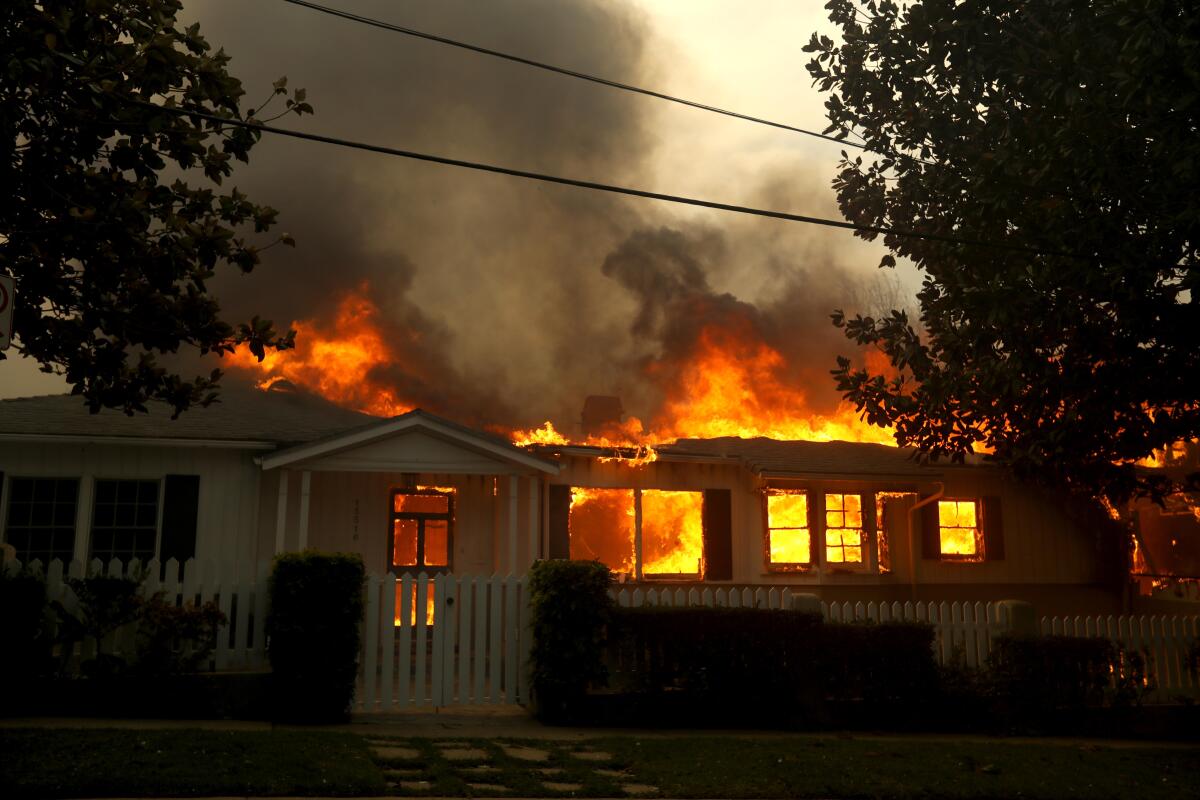Sunset Boulevard in ruins: Fire’s massive scale comes into focus in Pacific Palisades

- Share via
By Wednesday morning, it looked as if a bomb had detonated on Sunset Boulevard.
As the catastrophic Palisades fire receded from one of the city’s iconic thoroughfares, smoke and ash rendered the once-picturesque landscape into something oddly lunar.
Coverage of the fires ravaging Altadena, Malibu, Pacific Palisades and Pasadena, including stories about the devastation, issues firefighters faced and the weather.
There were charred buildings, some slightly damaged, others fully destroyed. A burned-out Shell station, the pumps intact but the convenience store gone; a Bank of America in a historic building hollowed out by fire, the metal skeletons of the ATMs out front left twisted by the intense heat.
At a police blockade, residents of the Palisades begged LAPD officers to let them through to check on their homes and pick up essential medications.

The Palisades inferno broke out Tuesday morning near Piedra Morada Drive and was brutally whipped by gusting winds. It burned through more than 11,802 acres by Wednesday afternoon, snaking west into Malibu and east toward Brentwood and leaving widespread devastation in its wake.
Tens of thousands of residents have been forced from their homes. Authorities reported an unspecified number of “significant” injuries as concurrent catastrophic fires raged in other parts of the city. The L.A. County Sheriff’s Department counted two arrests for looting as thieves tried to plunder wealthy neighborhoods that had been evacuated.
“Despite the exceptional nature of what’s transpired and is transpiring, I fear we are getting a look at a new, terrible and tragic normal,” said William Deverell, a historian and director of the Huntington-USC Institute on California and the West.
The California National Guard has sent 200 personnel to help fight four major fires in L.A. County, and federal and out-of-state agencies are also pledging help.
Much of Pacific Coast Highway and its homes and landmarks between Will Rogers State Beach just north of Santa Monica and Carbon Beach in eastern Malibu lay in ruins Wednesday. Large swaths of coastal homes perched along the highway were reduced to smoldering rubble, crumbling onto the beach and into the sea.
Cozy homes and multimillion-dollar beach palaces that once hugged the coastline — all gone. Beloved longtime businesses and emblems of the local canon — also wiped out.
In Santa Monica, doctors at the emergency department at Providence Saint John’s Health Center treated patients suffering from smoke inhalation, eye irritation and minor burns.
Dr. Ali Jamehdor urged people with cardiac or respiratory issues to stay inside and for everyone to be cautious amid battering winds that sent debris flying into the air. Surgeries at the Santa Monica hospital had been postponed Tuesday night and were expected to resume Thursday.

Much of what remained Wednesday of the “Alphabet Streets” neighborhood of the Palisades, a mostly flat residential grid in a U-shaped pocket just north of Sunset Boulevard, was blackened rubble and dust.
Although much of the Palisades was cordoned off, James Fynes, 40, found a back staircase into the area. He’d come to check on the home of his friend’s parents, who had moved in last year after three years of construction.
“This is insane,” he repeated as he walked through street after street of charred cars and homes reduced to nothing. “I can’t believe there’s no water.”
Through every incinerated block, reminders of the property owners’ affluence lingered: a home gym burned nearly beyond recognition, then a blackened hot tub, next the husks of multiple cars parked in a garage.
On most blocks, the only things left standing were fireplaces. Power lines sagged down onto ruined streets. Some homes were still on fire.
For John Lightfoot, 56, each business that burned down had memories attached: the bank he used for decades, the little cafe he frequented, both gone.
Coverage of the fires ravaging Altadena, Malibu, Pacific Palisades and Pasadena, including stories about the devastation, issues firefighters faced and the weather.
A few blocks away, Michael Payton, store director of the nearby Erewhon, came to survey the damage. The business had survived, but so much else was gone.
“The whole Palisades is done. The whole town is done,” he said. “This is complete devastation.”
Fear blanketed Los Angeles as the Palisades and other fires raged and winds screamed, with seemingly no corner of the city entirely out of danger.
Some residents reported evacuating more than once, as fire followed them toward the homes of friends or family in “safe” zones. Others learned their homes had burned from afar, through fire or security alarms that alerted their phones.
“Historically, from my experience, when we talk about disasters in Southern California, in L.A. County, and specifically when we talk about fire disasters, there seems to be a disconnect between those of us who live in the flats, far from the foothill areas,” said historian D.J. Waldie.

From the flats, the flames at higher elevations can seem far off and like “somebody else’s Los Angeles, where things burn down all the time,” Waldie said.
But that paradigm was upended Tuesday night, as a wide swatch of lower-elevation Santa Monica was put under an evacuation warning.
By midday Wednesday, distressed Santa Monica residents gasped in the smoke and strained against 40-mph wind gusts, dragging pets and suitcases to their cars to flee the mandatory evacuation zone north of San Vicente. And yet two blocks away, on Marguerita Avenue near Ocean Avenue, a construction crew calmly worked at an apartment building.
“We have to survive; that’s why we’re still here,” said Josue Curiel, who lives in Inglewood and is originally from Jalisco, Mexico. Everyone on his crew of about half a dozen was also born south of the border.
“If you’re a worker, you’re hungry, so that’s what it is.”
With their ladder lashed to the building to help steady it in the howling wind, they labored to repair a water-damaged balcony — unrelated to the natural disaster raging around them.
Coverage of the fires ravaging Altadena, Malibu, Pacific Palisades and Pasadena, including stories about the devastation, issues firefighters faced and the weather.
“I was planning to have the day off,” while watching the news last night, Curiel said with a shrug, but he awoke to find the job was still on. “A lot of people are still working.”
Mike Flannigan, a professor at Thompson Rivers University in Canada’s British Columbia who studies wildfires, said there’s a simple recipe that applies to California blazes: vegetation, ignition and conducive weather, which typically is hot and dry winds.
“If you got all three, then you got a wildfire,” he said.
Those elements helped the Palisades fire move swiftly and tear through neighborhoods nestled along canyons and hillsides.
On east-west corridors through central L.A., the brown fronds of palms — queen, fan and other varieties — were scattered on the streets and sidewalks like carrion. None stood a chance against the fierce winds.
Heading west from the Miracle Mile area, the eerie drift of smoke under a midmorning sun bathed the landscape in amber and ochre. The plume so intensely darkened the sky that street and residential lights with photocells designed to turn on at dusk were illuminated — human technology tricked by the inferno.
Former Police Commission President Steve Soboroff, a West L.A. resident, said that each of his five children, all of whom live in the Los Angeles area, had evacuated their homes.
“This isn’t just a fire,” Soboroff said. “You contain a fire, build a ring around the fire. This is like a thousand fires. It’s just impossible. I think back to the Great Chicago Fire. I don’t know anything here that’s ever been like this, because of the density. It is just a worst-case scenario.”
More to Read
Sign up for Essential California
The most important California stories and recommendations in your inbox every morning.
You may occasionally receive promotional content from the Los Angeles Times.

















